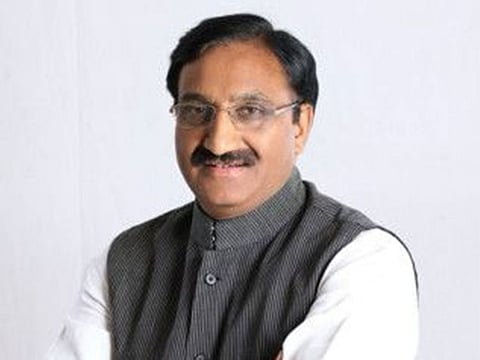Ramesh Pokhriyal: The extraordinary story of India’s education minister
The literary-political journey of ‘Nishank’ stands out for its remarkable determination

Ramesh Pokhriyal “Nishank” is currently India’s Education Minister. Indeed, as Director of Indian Institute of Advanced Study, Shimla, I must offer a disclaimer at the very outset that he is my Minister too. Needless to say, the views expressed in this column are not related to my official position but are personal. Minister Nishank’s winning the Vatayan-UK Lifetime Achievement Award on Saturday, 21 November 2020, gives us an occasion to review his remarkable political and poetic career.
Also known as “Dr. Nishank,” owing to the honorary DLitts conferred on him, his nom de plume or pen-name, was reportedly given to him by the Uttarakhand writer, Nand Kishore Dhaundiyal. “Nishank” means confident, determined, sure, positive, convinced, unshaken, assured, unwavering, qualities that certainly apply to him. Born on 15 July 1959 in Pinani, a remote village in Pauri district of Uttarakhand, Nishank’s beginnings, as a horticulture worker’s (mali) son, were humble.
About those days of hardship and struggle, he reminisces: “I started my career as a schoolteacher. I saw many phases in life in which I felt that going ahead was impossible. … I gave my heart and soul to do even the impossible tasks. … It’s clear that only great toil contributes towards every great success.”
Indeed, of the values that inform Nishank’s writings, humanity and humility, coupled with hard work and determination stand out. Nishank is a writer who inspires common readers with positive thoughts and constructive views. In fact, he has popularised a new genre of writing in Hindi which we may call inspirational writing.
Going back to his political career, Nishank’s relentless striving paid off. In 1987 he was appointed the central spokesperson of the Uttar Pradesh (later Uttarakhand) Sangharsh Samiti. From 1991 to 2012, he was elected five consecutive times to the Legislative Assembly first of India’s largest state, Uttar Pradesh, and, after its formation in 2000, of Uttarakhand.
Since 1996, a Cabinet Minister in UP, then Uttarakhand, Nishank became the 5th Chief Minister of the latter state from June 2009 to September 2011. After moving to national politics, he was twice elected to the Lok Sabha from the prestigious Haridwar constituency. Today, Nishank has risen to one of the highest cabinet positions in the country.
An author par excellence
No wonder, most well-informed Indians now know his place in India’s political establishment. But, perhaps, very few know that Dr Nishank is also an important author, with over fifty books to his name. These include volumes of poems, short stories, novels, travelogues, biography, history, and inspirational exhortation. His vast and growing oeuvre, mostly in Hindi, but lately in English too, is worth exploring at some length.
Nishank is neither a practitioner of pragativaad (progressivism) nor prayogvaad (experimentation), neither an activist nor a member of any literary avant garde, neither jilted lover nor romantic sensationalist. One crucial and useful way to locate Nishank is in the tradition of poetic nationalism and patriotism. Citing Francesca Orsini’s The Hindi Public Sphere (2006), Gopal Sharma likens Nishank’s works to eminent writer-politicians like Madan Mohan Malaviya and Purushottam Das Tandon, who “established Hindi as a legitimate language of political exchange and the language of Swarajya.”
In this context, it is vital to recall the close connection, personal, poetic, and political between Nishank and the former Prime Minister Atal Bihari Vajpayee, himself a noted poet, writer, and eloquent orator. At the launch of one of Nishank’s books, Vajpayee said, “Despite being in the active politics, the vigour with which Dr Nishank is constantly struggling and creating new space for himself in the realm of literature cannot be attained by an ordinary man.” Vajpayee adjured Nishank, “You stop anything but never stop writing.”
Tradition of regionalism
Another way to locate or understand Nishank’s works would be in the tradition of regionalism or what in Hindi literary criticism is termed aanchalikta. Arguably beginning with the doyen of Hindi literature, Premchand, then taken to new heights by Phanishwar Nath “Renu” in Maila Aanchal, this special variety of regionalism in Hindi literature celebrates the life and culture of a well-defined and specific geo-cultural space.
For Nishank, it is clearly Uttarakhand, a state he himself helped to form, separating it from Uttar Pradesh. As far as his home state is concerned, Nishank, to invoke Upendranath “Ashk,” is really a ghumta aina, wandering mirror. A people’s writer, Nishank’s works not only abound with the common folk, mostly of his own knowing and experience, but also the flora, fauna, and landscapes of his beloved Uttarakhand.
Called “Dev Bhoomi,” or the land of the Gods, this beautiful, mostly hilly state in the lower Himalayas is not only famous for its natural beauty, but also for its simple men and women. From the heights of the Himalayas to the plains of Haridwar, Uttarakhand is suffused with an energy of piety and simplicity rarely to be found among the crowded and overpopulated large cities of India or even the teeming towns in the plains. It is this special quality that Nishank tries to capture and portray in his writings.
Sign up for the Daily Briefing
Get the latest news and updates straight to your inbox







